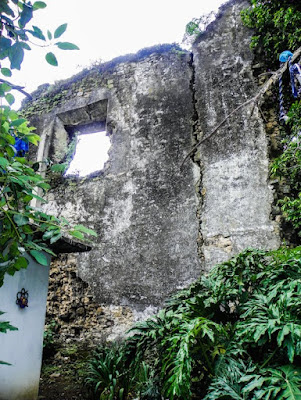The Church Frieze
While most commentary on the murals has been focused on the Battle scenes along the nave of the church, which take the form of a giant frieze, another less noted frieze runs around the nave at the roofline, using the same basic design and coloration, as well as some of the same imagery as the battle frieze, with medallions that include warriors, centaurs and other mythical beasts, framed by acanthus foliage.
Because of its height, uneven condition, and lacking the scale, narrative drama and vivid detail of the lower frieze, its effect is dulled. And perhaps because of this, unlike the battle friezes below, the upper frieze was never whitewashed and is unaltered.
Several other friezes embellish the church and convento.
 |
| Sacristy frieze with medallion of the Agony in the Garden |
In the sacristy, as in the church, an upper frieze mirrors the narrative frescoes on the walls below, depicting Passion scenes and portraits of saints in the same style but set in medallions within a matrix of foliage and ornamental strapwork.
Monochrome foliated friezes survive around the cloisters and stairwell framing escutcheons of religious and Augustinian insignia in a parade of exotic beasts, including dolphins, peacocks and pegases.
See our earlier posts on the convento murals of Ixmiquilpan: The Sacristy; Last Judgment;
text © 2018 Richard D. Perry
color images by Niccolo Brooker and Benjamin Arredondo






























